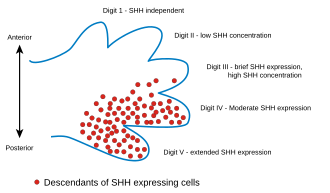Limb bud
Limb Bud
The limb bud is an essential structure in the embryonic development of vertebrates, giving rise to the limbs. Limb buds are small protrusions that appear on the sides of the developing embryo and are the precursors to the arms and legs in humans and other tetrapods.
Development
Limb bud development begins with the formation of a small bulge on the lateral aspect of the embryo. This process is initiated by the mesoderm, which forms the core of the limb bud, and is covered by a layer of ectoderm. The mesodermal core contains mesenchymal cells that proliferate and differentiate to form the skeletal elements, muscles, and connective tissues of the limb.
Apical Ectodermal Ridge
The apical ectodermal ridge (AER) is a critical structure in limb bud development. It forms at the distal tip of the limb bud and acts as a signaling center that regulates the growth and patterning of the limb. The AER secretes growth factors such as fibroblast growth factors (FGFs) that promote the proliferation of mesenchymal cells in the underlying mesoderm.
Zone of Polarizing Activity
The zone of polarizing activity (ZPA) is another important signaling region located at the posterior margin of the limb bud. The ZPA produces sonic hedgehog (Shh), a signaling molecule that establishes the anterior-posterior axis of the limb, influencing the development of structures such as the thumb and little finger.
Patterning and Differentiation
Limb bud development involves complex interactions between various signaling pathways that establish the three-dimensional pattern of the limb. The proximal-distal axis is regulated by the AER, while the anterior-posterior axis is influenced by the ZPA. The dorsal-ventral axis is controlled by signals from the dorsal and ventral ectoderm.
As the limb bud grows, the mesenchymal cells differentiate into chondrocytes, which form the cartilage models of the future bones. These cartilage models later undergo endochondral ossification to become bone. The myoblasts differentiate into muscle cells, forming the muscles of the limb.
Clinical Significance
Abnormalities in limb bud development can lead to congenital limb malformations such as polydactyly, syndactyly, and amelia. These conditions can result from genetic mutations or environmental factors that disrupt the signaling pathways involved in limb patterning and growth.
Related Pages
Transform your life with W8MD's budget GLP-1 injections from $125.
W8MD offers a medical weight loss program to lose weight in Philadelphia. Our physician-supervised medical weight loss provides:
- Most insurances accepted or discounted self-pay rates. We will obtain insurance prior authorizations if needed.
- Generic GLP1 weight loss injections from $125 for the starting dose.
- Also offer prescription weight loss medications including Phentermine, Qsymia, Diethylpropion, Contrave etc.
NYC weight loss doctor appointments
Start your NYC weight loss journey today at our NYC medical weight loss and Philadelphia medical weight loss clinics.
- Call 718-946-5500 to lose weight in NYC or for medical weight loss in Philadelphia 215-676-2334.
- Tags:NYC medical weight loss, Philadelphia lose weight Zepbound NYC, Budget GLP1 weight loss injections, Wegovy Philadelphia, Wegovy NYC, Philadelphia medical weight loss, Brookly weight loss and Wegovy NYC
|
WikiMD's Wellness Encyclopedia |
| Let Food Be Thy Medicine Medicine Thy Food - Hippocrates |
Medical Disclaimer: WikiMD is not a substitute for professional medical advice. The information on WikiMD is provided as an information resource only, may be incorrect, outdated or misleading, and is not to be used or relied on for any diagnostic or treatment purposes. Please consult your health care provider before making any healthcare decisions or for guidance about a specific medical condition. WikiMD expressly disclaims responsibility, and shall have no liability, for any damages, loss, injury, or liability whatsoever suffered as a result of your reliance on the information contained in this site. By visiting this site you agree to the foregoing terms and conditions, which may from time to time be changed or supplemented by WikiMD. If you do not agree to the foregoing terms and conditions, you should not enter or use this site. See full disclaimer.
Credits:Most images are courtesy of Wikimedia commons, and templates, categories Wikipedia, licensed under CC BY SA or similar.
Contributors: Prab R. Tumpati, MD

